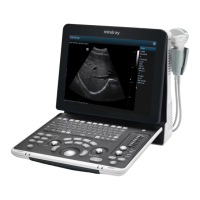Image Optimization 5-3
Rate
Dynamic
Range
Display when the function is
turned on
5.4.3 B Mode Image Optimization
Gain
To adjust the gain of the whole receiving information in B mode. The real-time
gain value is displayed in the image parameter area in the upper left corner of
the screen.
Rotate the <Gain/iTouch> knob clockwise to increase the gain, and
anticlockwise to decrease.
Increasing the gain will brighten the image and you can see more received
signals. However, noise may also be increased.
Depth
Description
This function is used to adjust the display depth of sampling, the real-time
value of which is displayed on the image parameter area in the upper left
corner of the screen.
Use the <Depth/Zoom> knob to adjust the depth;
The adjustable depth values vary depending upon the probe types.
Increase the depth to see tissue in deeper locations, while decrease the depth
to see tissue in shallower locations.
Depth increase will cause a decrease in the frame rate.
TGC
The system compensates the signals from deeper tissue by segments to
optimize the image.
There are 8-segment TGC sliders on the control panel corresponding to the
areas in the image.
To increase the gain compensation at an area of interest, move the TGC slider
to the right. To decrease the gain compensation at the corresponding area of
interest, move the TGC slider to the left.
About 1.5s after the adjustment is finished, the TGC curve disappears.
Effects
Adjust the signal gain for the certain image area to get a balanced image.
Frequency
This function is used to select the operating frequency of the current probe,
the real-time value of which is displayed in the image parameter area in the
upper left corner of the screen, where “F” represents B mode frequency, and
“FH” represents harmonic frequency.
Operation
Adjust it through [Frequency] on the image menu or rotate the
<Focus/Freq./THI> knob on the control panel, wherein “H” means the
harmonic frequency.
Values of frequency vary depending upon the probe types. Select the
frequency according to the detection depth and current tissue characteristics.

